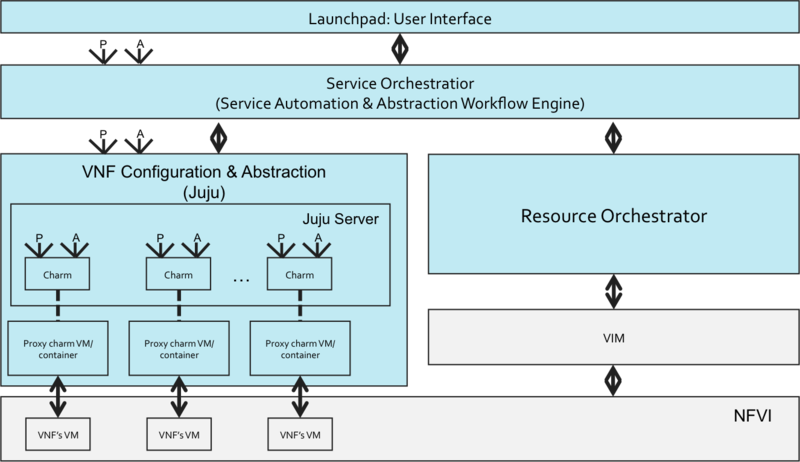(OLD) Release 0 HowTo guide for developers: Difference between revisions
No edit summary |
No edit summary |
||
| Line 1: | Line 1: | ||
The OSM code is organized into four modules. The following diagram illustrates how these four components fit together: <br> | The OSM code is organized into four modules. The following diagram illustrates how these four components fit together: <br> | ||
[[File:osm_architecture.png]] <br><br> | [[File:osm_architecture.png|800px]] <br><br> | ||
'''Launchpad (User Interface):'''Launchpad provides the user interface to the OSM orchestrator. From the Launchpad user can manage the catalog, compose the NS/VNF descriptors and perform the lifecycle management on Network Services. In addition, the UI also provides the ability execute the NS/VNF level configuration primitives. <br> | '''Launchpad (User Interface):''' Launchpad provides the user interface to the OSM orchestrator. From the Launchpad user can manage the catalog, compose the NS/VNF descriptors and perform the lifecycle management on Network Services. In addition, the UI also provides the ability execute the NS/VNF level configuration primitives. <br> | ||
'''Service Orchestrator (SO):''' Service Orchestrator is responsible for End-to-End service orchestration. It is responsible for instantiating the NS, and starting the configuration plugins such as JUJU charms.<br> | '''Service Orchestrator (SO):''' Service Orchestrator is responsible for End-to-End service orchestration. It is responsible for instantiating the NS, and starting the configuration plugins such as JUJU charms.<br> | ||
'''Resource Orchestrator (RO):''' Resource Orchestrator is responsible for creating and placement of compute and networking resources. It is also responsible for interfacing with SDN controller. <br> | '''Resource Orchestrator (RO):''' Resource Orchestrator is responsible for creating and placement of compute and networking resources. It is also responsible for interfacing with SDN controller. <br> | ||
'''Juju Charms (Charms):'''Juju charms provide the VNF abstraction and configuration for the VNFs. The Service Orchestrator interfaces with the JUJU charm to configure the VNF. | '''Juju Charms (Charms):'''Juju charms provide the VNF abstraction and configuration for the VNFs. The Service Orchestrator interfaces with the JUJU charm to configure the VNF. | ||
Revision as of 00:02, 6 May 2016
The OSM code is organized into four modules. The following diagram illustrates how these four components fit together:

Launchpad (User Interface): Launchpad provides the user interface to the OSM orchestrator. From the Launchpad user can manage the catalog, compose the NS/VNF descriptors and perform the lifecycle management on Network Services. In addition, the UI also provides the ability execute the NS/VNF level configuration primitives.
Service Orchestrator (SO): Service Orchestrator is responsible for End-to-End service orchestration. It is responsible for instantiating the NS, and starting the configuration plugins such as JUJU charms.
Resource Orchestrator (RO): Resource Orchestrator is responsible for creating and placement of compute and networking resources. It is also responsible for interfacing with SDN controller.
Juju Charms (Charms):Juju charms provide the VNF abstraction and configuration for the VNFs. The Service Orchestrator interfaces with the JUJU charm to configure the VNF.